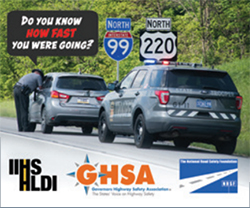
For more than 50 years, The National Road Safety Foundation, Inc. (NRSF) has been dedicated to reducing crashes, deaths and injuries on our nation’s highways by promoting safe driving behavior through greater public awareness. GHSA teamed up with NRSF to address active youth transportation, speeding and drowsy driving.
Active Transportation Grants
For the third consecutive year, GHSA and NRSF provided funding to State Highway Safety Offices (SHSOs) to develop, implement and evaluate youth active transportation safety programs with a focus on underserved and socioeconomically challenged communities. For 2024, the SHSOs listed below are partnering with local community-based organizations to promote safe walking, bicycling and scooter riding practices that can be replicated by other states.
- The Hawaii Department of Transportation’s (HDOT) Highway Safety Office and the Ka'u School District collaborated to enhance safe transportation for the youth of Ocean View, Naalehu and Pahala. This initiative is built upon qualitative research conducted by HDOT and the University of Hawaii aimed at addressing traffic safety issues in this underserved community. To promote safe walking from transit stops to school, students were provided reflective materials, whistles and shoes. In addition, community listening sessions helped to inform infrastructure and systems recommendations which were shared with local safety engineers and transit providers.
- The Idaho Office of Highway Safety partnered with the Idaho Walk Bike Alliance to provide several communities hands-on classroom instruction specifically curated for the state's roads. This project filled an educational void for middle and high school students, specifically bridging the gap between K-6 Safe Routes to School programming and high school-based driver education and training. Students learned about active transportation modes such as walking, biking and scooting, which provide equitable access to school for many students.
- The Maryland Department of Transportation Motor Vehicle Administration’s Highway Safety Office teamed up with the City of Salisbury and Salisbury University to train young leaders to be peer-to-peer educators. They used this training to help their peers learn about and adopt safe walking and bicycling practices.
- The Oregon Department of Transportation, in partnership with the state’s Safe Routes to School program, constructed a demonstration crosswalk and walking route in Odell that provides a safe way for elementary students to get to school. To involve youth in the project, a free after-school club for 5th-8th graders was created. The students took walking and rolling adventures within a mile of the school and engaged neighbors and local businesses in the demonstration project. The Odell Mid Valley Elementary School “Pumas” started a walking school bus which followed this route to and from school.
- The Texas Department of Transportation equipped its Traffic Safety Specialists with an outreach toolkit that they are using to host youth transportation safety events across the state. During the events, students learn about safe bicycling, road patterns and best practices when riding on the road. The events also feature interactive, simulated road scenarios that give students the opportunity to practice what they’re learning in a safe environment separated from motor vehicle traffic.
Speed Management Pilot Program
 GHSA partnered with NRSF and the Insurance Institute for Highway Safety (IIHS) to award a $100,000 grant to the Maryland Department of Transportation (MDOT) Motor Vehicle Administration’s Highway Safety Office to develop, implement and evaluate a speed management pilot program in rural Bishopville. MDOT and its partners leveraged engineering, equitable enforcement, education, public outreach and advocacy strategies simultaneously.
GHSA partnered with NRSF and the Insurance Institute for Highway Safety (IIHS) to award a $100,000 grant to the Maryland Department of Transportation (MDOT) Motor Vehicle Administration’s Highway Safety Office to develop, implement and evaluate a speed management pilot program in rural Bishopville. MDOT and its partners leveraged engineering, equitable enforcement, education, public outreach and advocacy strategies simultaneously.
The pilot, described in detail in an MDOT report, focused on a 2.4-mile section of the road that is a popular route for beachgoers in the summer months and is known to have a speeding problem. In July 2021, the lanes were narrowed by doubling the width of the painted edge and center lines to 10 inches to help slow traffic. In addition, speed feedback signs, which show drivers how fast they are going as they pass, were installed in two locations.
During the pilot project, IIHS researchers found that average speeds fell 9% and the odds that a vehicle on the road was speeding dropped by three-quarters. The effects largely faded once the measures were discontinued.
State Grants to Address Drowsy Driving
NRSF also provided grants for SHSOs to implement drowsy driving prevention programs and campaigns. From 2017 to 2019, 12 states received a total of $225,000 to address this prevalent but underreported problem. States used these funds to create public awareness campaigns, engage with high-risk groups such as teens and young adults, and develop training for law enforcement officials to recognize the signs of drowsy driving.
Learn about these innovative and creative projects here.
